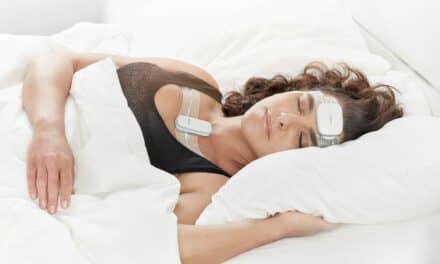 |
Auto-titrating positive airway pressure (APAP) devices currently have a small market foothold in the OSA sleep therapy marketplace, but that may be changing. There are several developments contributing to APAP’s gain in market share. First, the American Academy of Sleep Medicine (AASM) revised its APAP practice parameters earlier this year and announced its support for a separate reimbursement code for APAP. At the same time, sleep laboratories and home medical equipment (HME) providers are looking for a convenient and cost-efficient model for titrating unattended patients outside of the laboratory. The new Centers for Medicare and Medicaid Services (CMS) mandated trial period is also encouraging APAP manufacturers to design new technologies that provide clinicians with objective data that the therapy is working—and that patients are using it.
NEW PRACTICE PARAMETERS AND AASM SUPPORT
APAP’s traditionally low market share has been attributed to its higher cost, as well as the skepticism of some physicians about its clinical value over the less expensive CPAP.
However, some recent developments may boost APAP’s market presence in the wake of the new home sleep testing (HST) market.
Earlier this year, APAP’s cost and efficacy were addressed when the AASM’s standards and practices committee reviewed studies comparing APAP to CPAP and published revised APAP practice parameter recommendations in the January 2008 issue of the journal Sleep.
Several of these new recommendations are particularly significant to APAP and the HST market.
In particular, the new practice parameters stated:
- In patients without significant comorbidities, valid APAP machines can be used in self-adjusting mode for unattended treatment of patients with moderate to severe OSA.
- For patients with moderate to severe OSA without significant comorbidities, unattended APAP may be used to establish fixed CPAP treatment pressure.1
Timothy I. Morgenthaler, MD, is the former chair of the standards and practices committee of the AASM and a consultant in pulmonary care in sleep medicine for the Mayo Clinic, Rochester, Minn, and was the lead author of the AASM’s APAP review.
Despite the committee’s findings that APAP is a valid titration tool for certain patients, Morgenthaler is still cautious about physicians taking APAP readings at face value.
“When one uses an auto-titrating device, I think there is a need to carefully examine the actual data, and not just the read-off of the 90th percentile or 95th percentile or whatever the software plugs out,” says Morgenthaler. “[In] the studies that showed success in using auto titraters to find a fixed pressure, they really scrutinized the data to find segments where there was little leak, [and] where the device seemed to be behaving in a proper manner and then selected a pressure from that. A couple of them specifically cautioned against taking the 90th percentile off the readout. So that is a concern for the application of these devices to general practice.”
Morgenthaler also urged physicians to review their selection of APAP devices and to be vigilant with follow-up. He says, “It seems that certain devices may be used in an unattended way, but you have to have the right patients, you have to look at the specific data and select areas where things were going well for the patient, and then pick a pressure from that. Then you need to follow up to ensure that’s really going to work.”
A CODE FOR APAP? MAYBE.
Another recent development for APAP is the potential for improved reimbursement. With the new era in payor-sanctioned HST, physicians, sleep laboratories, and HME providers are calling upon the CMS to approve a separate and higher reimbursement code for APAP … again.
This will be the fifth time that an HCPCS code has been requested, but many believe that HST will finally push CMS to approve the code with a premium level of reimbursement. Another good sign is that (now former) AASM president Alex Chediak has written to CMS in support of the code—so long as APAP is used within AASM practice parameters.
Manufacturers are hopeful about obtaining APAP approval this time.
Beth Guevara, manager of reimbursement planning for Philips Respironics, Murrysville, Pa, says, “APAP can play a significant role in the home testing area, because not only is there an opportunity to find the right pressure for the patient, but it’s also very valuable in providing the compliance data that CMS is now going to be requiring. So, it’s really going to be a great opportunity in situations where the physician feels that it’s appropriate to titrate the patient in the home.”
Speaking personally and not for the AASM, Morgenthaler agrees that a code for APAP is long overdue. He says, “I really think it’s inappropriate that there hasn’t been a special reimbursement for the APAP. It’s really not the same device. Just from a fairness point of view, the device has advanced sensing equipment in it; it has advanced engineering in it; and it delivers a different kind of therapy. Since it’s also now being used in some cases to titrate therapy, certainly that’s quite different than what you would use a CPAP for.”
Simon Johnson, director of product management at ResMed, San Diego, is confident that APAP usage will increase when a code is issued. He recalls when heated humidifiers were finally approved. Before then, he says that between 20% and 40% of ResMed patients were using humidifiers with their devices. He says, “Today, [many more] people who end up on our flow generators are also on a heated humidifier, because now reimbursement is more financially viable.” Johnson is optimistic that there may be similar APAP growth after a positive code decision.
While supporting APAP having its own code, Morgenthaler points out a downside to approval. He says, “I could easily see CMS or insurers saying, ‘Fine, but could you please provide evidence that CPAP doesn’t work, or what are the real indications for using an auto titrater instead of CPAP?’ So that could happen as well, and then one would have to rethink, well, maybe [CPAP’s] appropriate. I’m not sure everybody needs to be on APAP.”
POTENTIAL COST SAVINGS WITH APAP
One of the arguments in favor of home testing has been that traditional laboratory sleep testing and CPAP titration studies are expensive. Proponents of HST say that portable monitors with APAP titration studies would reduce ever-rising health care costs for Medicare and other payors. It could also decrease costs associated with adjustment and dispensing of devices.
Johnson says, “The more automated you can make the therapy, the less cost you have, and the more profitable you are in the long-term, and the more happy and compliant the patient is.”
IMPROVED MONITORING AND REPORTING
As with CPAP flow generators, manufacturers continue to work on improving APAP algorithms and making pressures more comfortable and natural feeling for patients. They are also designing machines to be smaller, quieter, and more attractive.
APAP vendors are also addressing new CMS and other payor requirements that clinicians show “objective” data that patients are clinically benefiting from therapy during the 90-day trial period.
Consequently, APAP software associated with the device is more sophisticated than in previous generations.
Morgenthaler says, “Looking at the machine’s estimations of apneas, hypopneas, and so forth might be of some help in guiding my thinking as to whether we’re actually close to the therapy working or not.”
CMS’s 90-day trial period requirements are also inspiring manufacturers to design more sophisticated compliance features.
Typically, compliance data is recorded onto some type of data card and either mailed or personally delivered to clinicians. In addition, a handful of manufacturers have or will soon have an option to incorporate some type of telemedicine technology for data transfers to clinicians.
These telemedicine compliance systems are especially becoming popular with transportation companies, whose OSA-diagnosed drivers are often required to show therapy compliance in order to keep their jobs.
Morgenthaler sees the potential health costs benefit to these systems, but from a clinical perspective, he feels that eyeball-to-eyeball attention is what works best for him and his patients. He also questions clinicians becoming the APAP police.
“At some point, one needs to ask whose responsibility is this?” says Morgenthaler. “If people are taking prescription pills, how would they feel if we were counting their pills on a monthly basis? What I’m saying is that the patient has to take a certain amount of responsibility for their treatment.[Telemedicine technology] could be of use, but it could also be of abuse, as well.”
Tor Valenza is a staff writer for Sleep Review. He can be reached at [email protected].
REFERENCE
- Morgenthaler TI, Aurora RN, Brown T, et al; Standards of Practice Committee of the AASM. Practice parameters for the use of autotitrating continuous positive airway pressure devices for titrating pressures and treating adult patients with obstructive sleep apnea syndrome: an update for 2007. Sleep. 2008;31:141-7.





